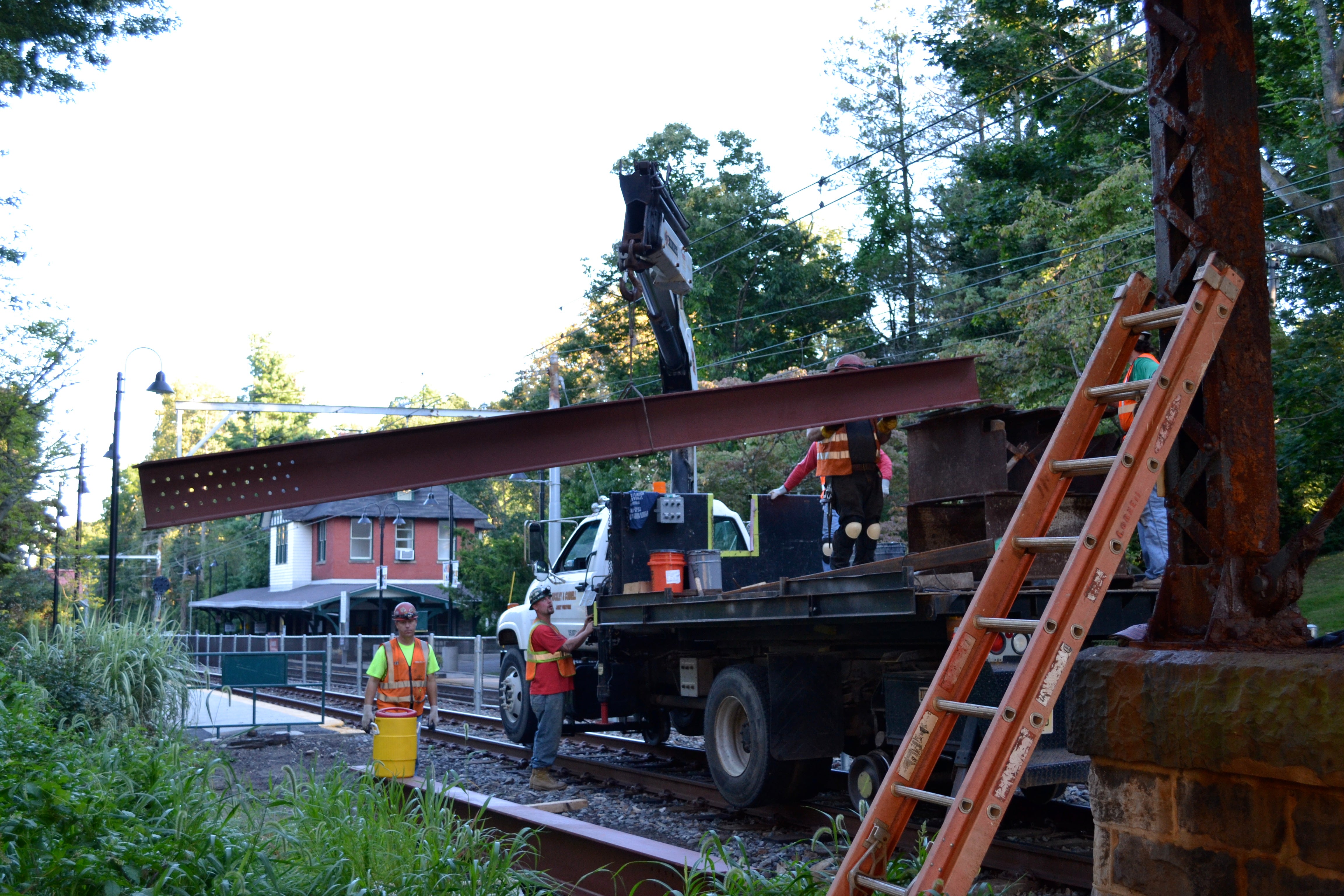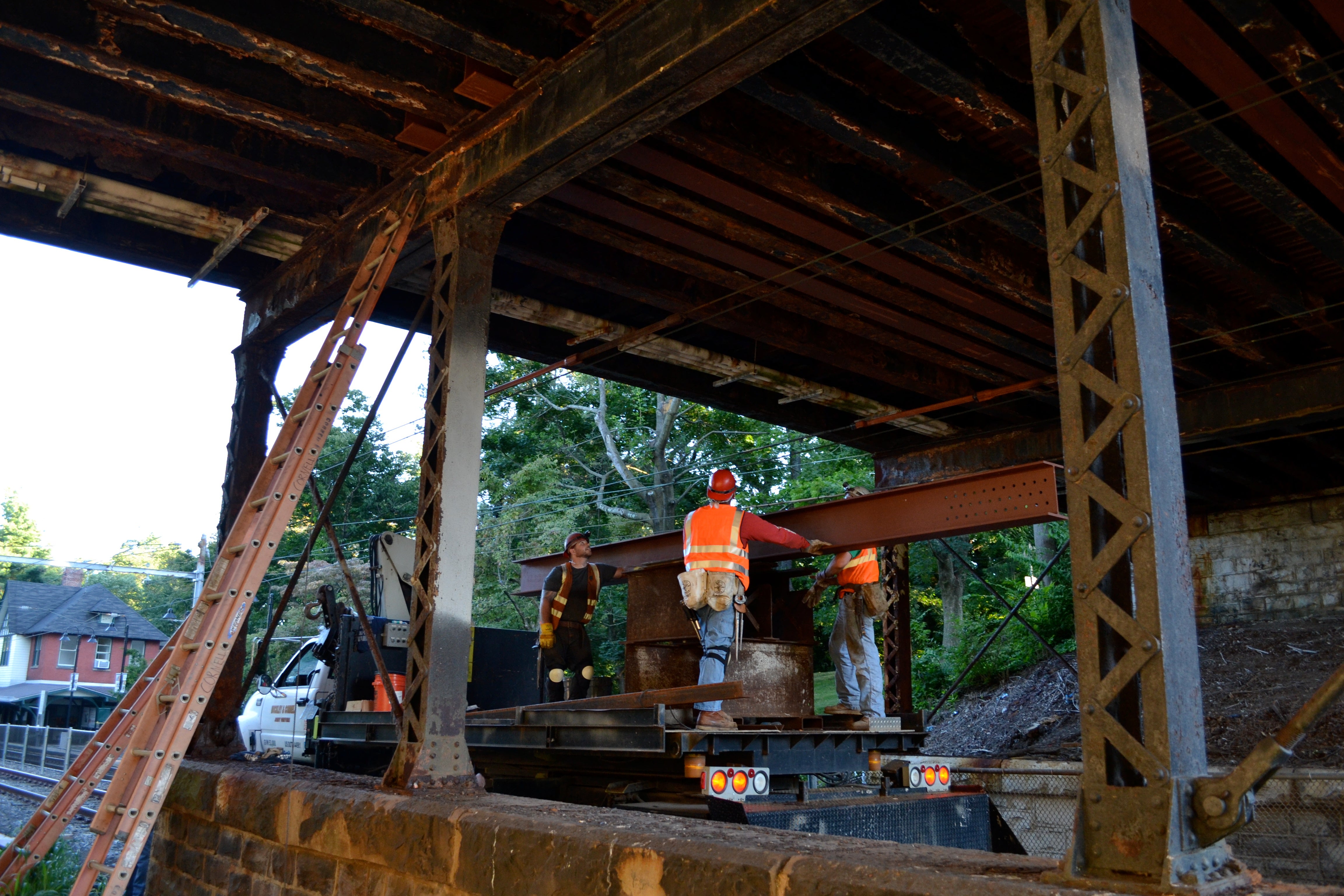Streets Department completes emergency bridge work, hopes for future funding

In 2005, large sections of two steel support beams beneath the Willow Grove Ave. Bridge near SEPTA’s St. Martins Station disappeared. They corroded to the point that they crumbled and essentially vanished. The typical driver or pedestrian on top of the bridge would never have known, but luckily, the Philadelphia Streets Department was on the case.
The department took a few precautionary measures and stepped up its inspections. Then, during the annual inspection this summer, Streets discovered things had gotten much, much worse.
“This is actually deteriorating faster than any of the other bridges I’ve worked on,” said Darin Gatti, chief engineer at the Streets Department.
The Willow Grove Ave. Bridge stretches across SEPTA’s regional rail tracks between St. Martins Lane and Seminole Street in Chestnut Hill. Beneath the surface, entire beams had layers of soft, flakey corrosion. In one spot there was a hole four-inches tall and 18-inches long. Gatti said most of the holes were not there when the bridge was inspected the year before, meaning in one year rust ate clear through multiple steel beams.
“When a bridge gets to a certain point in its life, the deterioration escalates and it’s almost impossible to predict that,” he said.
According to Gatti and Michael Carroll, director of engineering and special projects at the Mayor’s Office of Transportation and Utilities (MOTU), situations like this are bound to become more common unless transportation funding increases at the state and federal levels.
“You get to the point where the deterioration accelerates, and that’s because you haven’t been able to do the repairs over the last decade,” Carroll said. “Every year you’re not doing your maintenance you’re playing Russian Roulette with your infrastructure.”
Of the 150 vehicle bridges that the City of Philadelphia maintains, 42 are structurally deficient. Twenty years ago, there was more money and the city was rebuilding bridges faster than they were deteriorating, Gatti said. Ten years ago the money started to tighten up, and now the city is falling behind in its repair work.
“It just keeps getting more and more expensive, and the money seems to be shrinking,” Gatti said.
Repairing Willow Grove Ave. Bridge
Due to the level of corrosion on the Willow Grove Ave Bridge, the Streets Department was forced to find funding for immediate repairs.
This past weekend crews completed an approximately $92,000 reinforcement project, in which they lifted and swung eight steel beams into place beneath the bridge and between the existing, corroded beams. The new beams, each made of two long, I-beams weighing 800 pounds and a 300 pound steel plate that holds the two together, will buy the Streets Department time until the end of 2014, when the department plans to replace the bridge all together.
Since the department is already in final design phase on the new bridge, Gatti said, “We want to put in as little money as possible and keep it safe.”
One way the Streets Department saved money was by coordinating with SEPTA and piggybacking off of repair work the authority is doing along the Chestnut Hill West (CHW) Line. Because the bridge is just inches above SEPTA’s regional rail catenary power lines, electricity through the wires has to be turned off for bridgework. Since SEPTA was already planning to turn the power off for its maintenance projects, the Streets Department saved on fees it would have faced to turn the power off for its own work.
“It’s not easy,” Gatti said. “These wires have a lot of power in them. It takes a lot of effort to schedule a shutdown of these lines.”
On Saturday, SEPTA’s crews stepped off the CHW tracks at 5 p.m., just before the Streets Department’s contracted crew stepped on. A SEPTA engineer overseeing the authority’s work called the partnership a “well-oiled machine.”
A new bridge to match, improve on the old
The original Willow Grove Ave Bridge was built in 1893 on thick stone abutments. In 1963 the bridge was removed and the current steel structure was built on top of the masonry.
Since the bridge is in a historic district, the Streets Department will take efforts to maintain its authentic appearance. Right now the department is going through the historic clearance process. Plans include keeping but reinforcing the original stonework and incorporating design elements that match SEPTA’s historic St. Martins Station, which is next to the bridge.
If all goes as planned, Streets will close the bridge in late 2014 and rebuild it over the course of a year and a half.
“We really don’t know the cost until we’re through final design and because money is tight, if funding is off that means delays somewhere,” Gatti said.
Once it is built, the new bridge could last 100 years thanks to advancements in paint, steel and concrete technology as well as lessons engineers have learned over time about what works best and what to avoid. The new steel that the Streets Department installed during this recent repair work will be saved so that it can be reused on other bridge projects.
Both Streets and MOTU are hoping legislators come through with more transportation funding.
“It’s tight for everybody,” Gatti said. “People really don’t want more taxes. Hopefully we can come up with more financing options.”
WHYY is your source for fact-based, in-depth journalism and information. As a nonprofit organization, we rely on financial support from readers like you. Please give today.


























